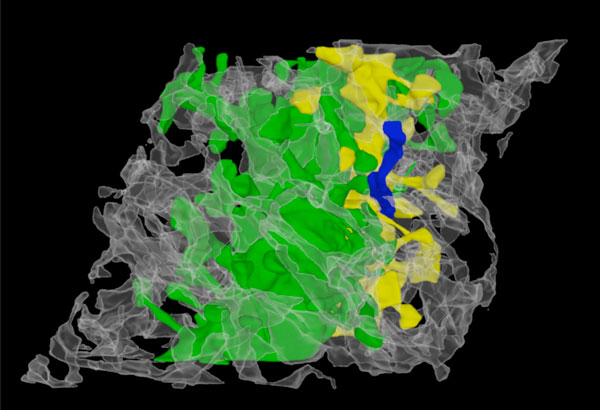Terrence Sejnowski
Research
The goal of my laboratory is to discover the principles linking brain mechanisms and behavior. The laboratory uses both experimental and modeling techniques to study the biophysical properties of synapses and neurons and the population dynamics of large networks of neurons. New computational models and new analytical tools have been developed to understand how the brain represents the world and how new representations are formed through learning algorithms for changing the synaptic strengths of connections between neurons. Some of the questions that my laboratory is exploring include:
How do neurons communicate at synapses? Monte Carlo models of molecular diffusion and interactions at synapses are being used to understand the mechanisms underlying the release of neurotransmitter from presynaptic terminals, the activation of receptors on the postsynaptic neuron and subsequent biochemical pathways that lead to short-term and long-term changes in the synapse. Single molecules at synapses are probed with 3-D random access 2-photon microscopy to locate important molecules and follow them as they diffuse within a spine.
What regulates the flow of information into the cerebral cortex and between cortical areas? My laboratory has shown that cortical neurons are capable of initiating spikes precisely and reliably. We have used detailed models of neurons to explore the role of spike time synchrony in reliably transmitting information between populations of neurons and in attentional modulation of firing rates. Fast-spiking inhibitory neurons are studied in vitro to examine their role in synchronizing other neurons. EEG and fMRI recordings have been analyzed with Independent Component Analysis (ICA), an algorithm for blind source separation developed in my lab, to explore the global flow of information in the cortex.
Why do we sleep? As we fall asleep, the patterns of cortical activity become more spatially and temporally coherent, especially at low frequencies, and during the night the brain cycles between REM sleep and slow wave sleep. The mechanisms underlying these sleep rhythms are being explored with large-scale network models of neural populations. New algorithms have been found to automatically classify sleep states from single EEG recordings.

Select Publications
- Qian, N. and Sejnowski, T. J., (1988). Predicting the secondary structure of globular proteins using neural network models. Journal of Molecular Biology 202:865-884.
- Steriade, M., D.A. McCormick and T.J. Sejnowski (1993). Thalamocortical oscillations in the sleeping and aroused brain. Science 262:679-685.
- Mainen, Z.F. and T.J. Sejnowski (1995). Reliability of spike timing in neocortical neurons. Science 268:1503-1506.
- Bell, A.J. and T.J. Sejnowski (1995). An information-maximization approach to blind separation and blind deconvolution. Neural Computation 7:1129-1159.
- Montague, P.R., P. Dayan and T.J. Sejnowski (1996). A framework for mesencephalic dopamine systems based on predictive Hebbian learning. Journal of Neuroscience 16(5):1936-1947.
- McKeown, M.J., S. Makeig, G.G. Brown, T.-P. Jung, S. Kindermann,A.J. Bell and T.J. Sejnowski (1998). Analysis of fMRI by blind separation into independent spatial components. Human Brain Mapping 6:1-31.
- Makeig. S., M. Westerfield,T.-P. Jung, S. Enghoff, J. Townsend,E. Courchesne and T.J. Sejnowski (2002). Dynamic brain sources of visual evoked responses. Science 295:690-694.
- Coggan, J. S., T.M. Bartol, E.I. Esquenazi, J.R. Stiles, S. Lamont, M.E. Martone, D.K. Berg, M. Ellisman and T.J. Sejnowski (2005). Evidence for ectopic neurotransmission at a neuronal synapse. Science 39:446-451.
- Behrens, M.M. and T.J. Sejnowsk (2009). Does schizophrenia arise from oxidative dysregulation of parvalbumin-interneurons in the developing cortex? Neuropharmacology 57:193-200.
- Wang, H.P., D. Spencer, J.-M. Fellous and T.J. Sejnowski(2010). Synchrony of thalamocortical inputs maximizes cortical reliability. Science 328:106-109.
Biography
Dr. Sejnowski received his Ph.D. in physics from Princeton University. He was a postdoctoral fellow at Princeton University and the Harvard Medical School. He served on the faculty of Johns Hopkins University and was a Wiersma Visiting Professor of Neurobiology and a Sherman Fairchild Distinguished Scholar at Caltech.

